Archive:Crime statistics
- Data from January 2014. Most recent data: Further Eurostat information, Main tables and Database.
This article presents recent statistics on crime and criminal justice in the European Union (EU). As statistics currently available reflect the diversity of policing and legal systems within the EU, comparisons of crime statistics between EU Member States should focus on trends over time, rather than directly comparing levels between countries for a specific year, given that the data can be affected by a range of factors, including different levels of criminalisation, the efficiency of criminal justice systems, and police recording practices. Furthermore, not all crimes are recorded by the police.
The latest collection of data indicates a general tendency towards a decrease in the levels of recorded crime across European Union Member States between 2007 and 2012. The number of most types of crimes recorded by the police in the European Union has fallen. The number of offences concerning drug trafficking, robbery, violent crimes and above all motor vehicle thefts decreased for the period 2007 to 2012. Domestic burglary is a category with a rising trend between 2007 and 2011.
Main statistical findings
Crimes recorded by the police
The crime statistics presented here cover offences recorded by police in the Member States of the EU and some other European countries. These figures do not purport to describe all crime in Europe: some crime goes unreported and changes in rates of particular offences may result from new policing strategies or methodological changes.
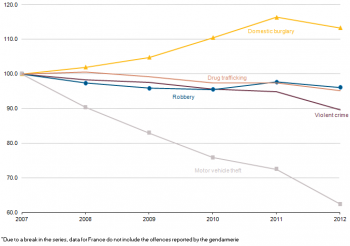
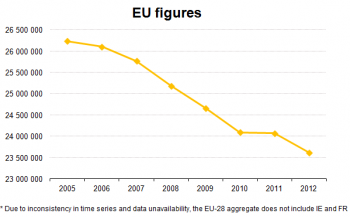


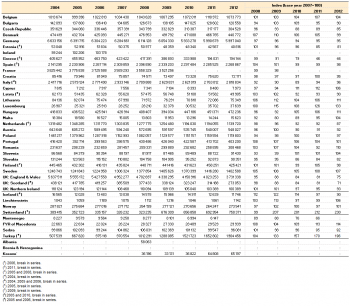
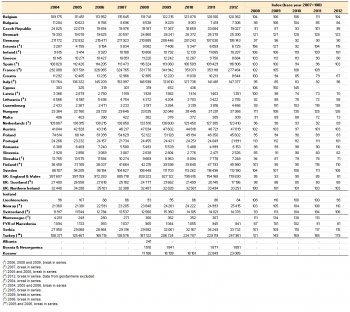

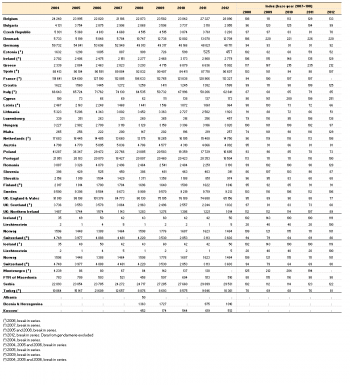
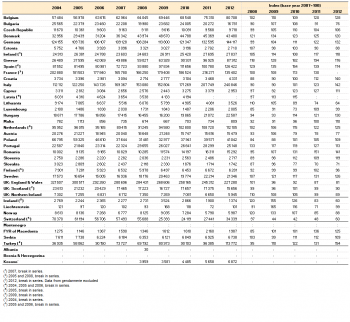
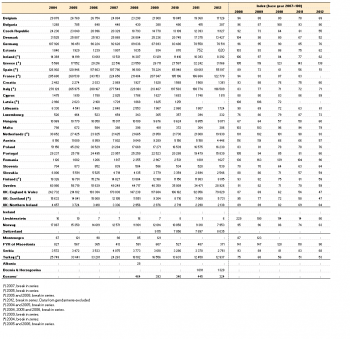

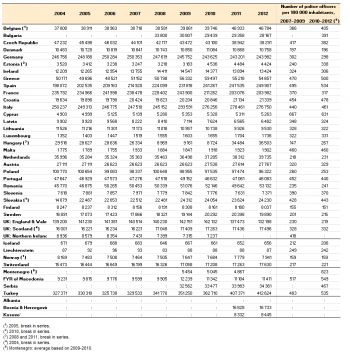
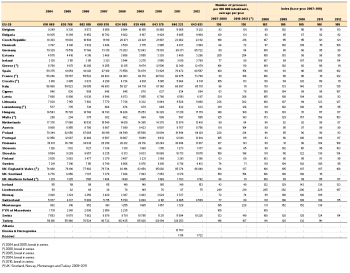
There is usually no straight match to be made in types and levels of crime between countries, because legal and criminal justice systems differ in such areas as: definitions of crimes[1]; methods of reporting, recording and counting crimes; and rates of reported to unreported crime[2].
National figures have been aggregated to provide EU level estimates for the purpose of identifying overall trends. Any inferences at the EU or Member State level should be based on trends over time.
Total recorded crime
The figures for total recorded crime[3] show only offences against the penal or criminal code; less serious crimes (misdemeanours) are excluded. The number of crimes recorded in the EU has been steadily decreasing since 2005 (see Figure 2), with 10 % fewer crimes recorded in the EU in 2012 than 7 years earlier.
While crimes linked to drug trafficking, robbery and violent crimes decreased between 4 and 10 % for the period 2007 to 2012, the number of motor vehicle thefts has fallen substantially faster over the same period (-37 %), confirming the already downward trend.
In contrast, domestic burglary is a category with a rising trend in the European Union. Compared to 2007, 14 % more cases of domestic burglary were reported in 2012.
When looking at the detailed national figures, ten EU Member States saw their number of crimes increase within this seven-year period (see Table 1). In contrast, total recorded crime decreased in 16 EU countries, the most noticeable changes being recorded in Greece (-54 %), Slovakia (-18 %), England & Wales and Scotland, with respectively (-25 %) and (-29 %).
England & Wales has largely influenced the EU downward trend with the largest decrease of crimes in terms of registered cases (over 1.2 million) among EU Member States over this period.
Beyond the EU borders, the total number of crimes recorded by the police in Turkey increased by 96 % between 2007 and 2012 (following a break in the series in 2006).
Violent crime
Figures for violent crime comprise violence against the person (such as physical assault), robbery (stealing by force or threat of force) and sexual offences (including rape and sexual assault). A detailed analysis of this crime type is difficult because not all Member States use the standard definition. Furthermore, due to a break in the series, 2012 violent crime data for France do not include figures reported by the gendarmerie, therefore, comparisons with total violent crimes registered for the reference year 2011 will be misleading.
However, the general trend at the EU level shows a decline of about 10 % in the number of violent crimes recorded between 2007 and 2012.
This overall decline is strongly influenced by the figures from England & Wales, where there was a fall of over 165 thousand violent crimes recorded between 2007 and 2012 (Table 2).
Looking at other Member States, the picture appears heterogeneous, with significant rises between 2007 and 2012 in Luxembourg (+38 %), Hungary (+26 %) and Denmark (+23 %) and large decreases in Lithuania (-42 %), Croatia (-33 %), Scotland (-32 %), and Latvia (-30 %).
Homicide
Homicide is defined as the intentional killing of a person, including murder, manslaughter, euthanasia and infanticide. It excludes death by dangerous driving, abortion and assisted suicide.
Homicides are reported fairly consistently and definitions vary less between countries than for other types of crime. The results presented are for completed homicides, except for Latvia where the figures include attempted homicide.
In some countries, the police register homicide as any death that cannot immediately be attributed to other causes. It may, therefore, be over-represented in the statistics.
The number of homicides recorded per each country is shown in Table 3.
The rate of homicides per 100 thousand inhabitants (Figure 3) reveals a downward trend: comparing the average ratios for 2007-2009 with those of 2010-2012, a decrease can be noted for all countries except Greece, Malta and Austria.
Despite decreases in the homicide rates for the three Baltic Member States, the number of homicides per 100 thousand inhabitants remained higher in these countries than in all other Member States.
Robbery
Robbery is a particular type of violent crime, defined as stealing by force or by threat of force. It includes mugging (bag-snatching) and theft with violence. Due to a break in the series, 2012 robbery data for France do not include figures reported by the gendarmerie, therefore, comparisons with total robberies registered for the reference year 2011 will be misleading.
At the level of the EU, the number of robberies has remained fairly stable, with a drop of 4 % since 2007. Despite the significant decrease in the number of robberies reported by the Baltic States (averaging -44 % for the period 2007-2012) and Scotland (-40 %), a few countries recorded very large increases. From 2007 to 2012 the number of robberies more than doubled in Denmark, Greece and Cyprus (Table 4).
Property crime
Property crime covers the stealing or destruction of property. Data for domestic burglary and theft of a motor vehicle are presented below and show different trends (see Tables 5 and 6). Due to a break in the series, 2012 domestic burglary and motor vehicle theft data for France do not include figures reported by the gendarmerie, therefore, comparisons with total domestic burglaries and motor vehicle thefts registered for the reference year 2011 will be misleading.
Domestic burglary is defined as gaining access to a dwelling by force in order to steal goods. Between 2007 and 2012 it increased by 14 % (Figure 1). Among the Member States with a continuous data series over this period, the highest increases in the number of recorded cases occurred in Greece (+76 %), Spain (+74 %), Italy (+42 %) and Romania (+41 %). Conversely, large decreases were reported by Lithuania (-36 %) and Slovakia (-29 %) over the five-year period (Table 5).
Theft of a motor vehicle covers thefts of cars, motorcycles, buses and lorries, as well as construction and agricultural vehicles.
Motor vehicle thefts have steadily fallen in recent years, partly as a result of technical improvements in vehicle theft deterrents. At the EU level, the number of offences recorded under this category of crime decreased by 37 % between 2007 and 2012, with a sizable fall in England & Wales. Spain has also seen large falls since the introduction of a new data series in 2008.
In Greece the number of motor vehicle thefts increased between 2007 and 2012 by 38 % (Table 6).
Drug offences
Drug trafficking is a sub-set of the broader class of drugs offences. It includes the illegal possession, cultivation, production, supplying, transportation, importing, exporting and financing of drug operations. Due to a break in the series, 2012 drug trafficking data for France do not include figures reported by the gendarmerie, therefore, comparisons with total drug trafficking registered for the reference year 2011 will be misleading.
Compared to the trends registered for the other types of crime, the number of drug trafficking offences has registered a relatively small reduction (-5 %) across EU Member States since 2007 (see Table 7). A steady decrease in drug trafficking was recorded in Germany, followed by Italy and England and Wales. A counter-balancing effect is created by most other EU countries (20 out of 28) which register increases in the number of drug trafficking offences between 2007 and 2012. Various breaks in series should however be observed, the most noticeable being that for Hungary between 2008 and 2009, which resulted in a large decrease in the number of registered offences.
Beyond the EU borders, the number of crimes linked to drug trafficking in Turkey more than tripled between 2007 and 2012 (following a break in the series in 2007).
The number of police officers remains stable
Police officers include criminal police, traffic police, border police, gendarmerie, uniformed police, city guard and municipal police, while excluding civilian staff, customs officers, tax police, military police, secret service police, special duty police reserves, cadets and court police. Variations in this definition do exist between jurisdictions however.
The total number of police officers across the EU has not changed significantly over the last few years. Excluding Northern Ireland and Bulgaria, there has been an increase of 2.3 % for the period 2007-2012 (see Table 8). Italy, Germany and Spain have the largest number of police officers at a national level, and together account for 45 % of the total number of police officers registered in the EU.
A steadily increasing prison population
The prison population figures comprise adult and juvenile convicted prisoners and pre-trial detainees in all types of prison establishments. Non-criminal prisoners held for administrative reasons (such as investigation of immigration status) are excluded.
In 2012, there were about 643 000 prisoners in the EU (excluding Scotland) and between 2007 and 2011 the total number of prisoners in the EU rose by 6 % (Table 9). When the average prison population rates for the two periods 2007-2009 and 2010-2012 are ranked (Figure 4) the three Baltic countries have the highest rates in both periods, although the prison population rate for Estonia has fallen to 253 prisoners per 100 000 in 2010-2012. Excluding Scotland, for the period 2010-2012 the EU average stands at 128 prisoners per 100 000 inhabitants, as opposed to 125 for the period 2007-2009. The lowest rates are found in the Nordic countries and Slovenia (between 60 and 72 prisoners per 100 000 inhabitants for the period 2010-2012).
Outside the EU, Turkey’s prison population more than doubled between 2005 and 2011.
Data sources and availability
Eurostat publishes statistics on crime and criminal justice systems from 1950 onwards for the total number of recorded crimes, and from 1993 onwards for a set of specific offences; the database also includes statistics for prison populations from 1987 onwards and the number of police officers from 1993 onwards.
Figures for the United Kingdom are reported for the separate jurisdictions of England and Wales, Scotland, and Northern Ireland.
As a general rule, comparisons of statistics on crime and criminal justice systems should be based upon trends rather than upon levels, on the assumption that the characteristics of the recording system within a specific country remain fairly constant over time. There are, however, a large number of breaks in time series and other methodological/definitional changes.
Comparisons of crime statistics between countries may be affected by a range of factors, including:
- different legal and criminal justice systems;
- the proportion of crimes reported to the police and recorded by them;
- differences in the timing of recording crimes (for example, when reported to the police, when a suspect is identified, and so on);
- differences in the rules by which multiple offences are counted;
- differences in the list of offences that are included in the overall crime figures.
Consequently, care should be taken when analysing the information presented.
Figures for the prison population may also be affected by a range of factors, including:
- the number of cases dealt with by the courts;
- the percentage of convicted criminals given a custodial sentence;
- the length of the sentences imposed;
- the size of the population on remand;
- the date at which the survey was conducted (especially where amnesties or other early release arrangements might apply).
The prison population should be measured as the total number of adult and juvenile prisoners (including pre-trial detainees) as of 1 September each year. The figures include offenders held in prison administration facilities, juvenile offenders’ institutions, drug addicts’ institutions and psychiatric or other hospitals.
Work is in progress to improve the comparability of crime statistics across the EU Member States. The development of a more comparable system of crime and criminal justice statistics is outlined in a European Commission Communication titled ‘Measuring Crime in the EU: Statistics Action Plan 2011-2015’ (COM(2011) 713 final).
See also
- Crime trends in detail
- Government expenditure on public order and safety
- European cities - demographic challenges
- Social protection statistics
Further Eurostat information
Publications
- Trends in crime and criminal justice, 2010 - Statistics in focus 18/2013
- Trafficking in human beings - 2013 edition - Working Paper
- Money Laundering in Europe - 2013 edition - Working Paper
Database
- Crimes recorded by the police (crim_gen)
- Crimes recorded by the police - NUTS 3 regions (crim_gen_reg)
- Crimes recorded by the police: homicide in cities (crim_hom_city)
- Crimes recorded by the police: historical data (total crime) 1950-2000 (crim_hist)
- Police officers (crim_plce)
- Prison population (crim_pris)
- Prison population: historical data 1987-2000 (crim_pris_hist)
Dedicated section
Methodology / Metadata
- Crime and criminal justice (ESMS metadata file - crim_esms)
Source data for tables and figures (MS Excel)
Other information
- Commission Communication COM/2006/437 final: Developing a comprehensive and coherent EU strategy to measure crime and criminal justice: an EU Action Plan 2006-2010
- The Hague Programme: strengthening freedom, security and justice in the European Union (Official Journal C 53 of 3.3.2005, p.11)
- The Stockholm Programme — An open and secure Europe serving and protecting citizens (Official Journal C 115 of 4.5.2010, p.1)
External links
- European Institute for Gender Equality
- European Monitoring Centre for Drugs and Drug Addiction
- Council of Europe
- European Sourcebook of Crime and Criminal Justice Statistics - 4th edition
- European Union Agency for Fundamental Rights
- United Nations Office on Drugs and Crime — Data and analysis
Notes
- ↑ For example, Greece, Cyprus, Luxembourg, Iceland and Liechtenstein do not distinguish "domestic burglary", and count all burglary (in shops, garages etc.). Their figures cannot therefore be compared directly with other countries which only include burglary in a dwelling.
- ↑ For further details of the factors which influence the crime figures, please see chapter Data sources and availability.
- ↑ The figures for violent crime, property crime and drugs offences do not add up to all crime; they are presented as a closer look at selected offences.